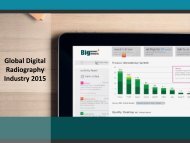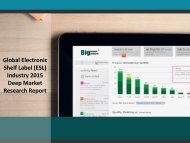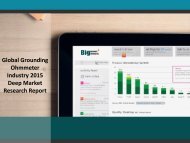o_19jdejh63uo218msh2v11sv6cfa.pdf
You also want an ePaper? Increase the reach of your titles
YUMPU automatically turns print PDFs into web optimized ePapers that Google loves.
Rheumatoid Arthritis<br />
Market to 2020 - A<br />
Crowded Market<br />
Characterized by<br />
Modest Growth
Report Overview<br />
Increasingly Crowded Market for Second-Line Therapies Improving Treatment Options for<br />
Moderate-to-Severe Rheumatoid Arthritis Patients<br />
Rheumatoid Arthritis (RA) is a chronic, progressive and currently incurable autoimmune<br />
disease that primarily affects joints. It is characterized by synovial inflammation and gradual<br />
bone erosion over many years, and disease progression results in stiffness and pain,<br />
especially in the hands and feet, which hinders patient mobility. Without treatment, the<br />
disease leads to joint destruction and disability. Prior to 1998, treatment options were<br />
limited to small-molecule disease-modifying therapies, such as Methotrexate (MTX),<br />
sulfasalazine and anti-malarials.<br />
However, while MTX is efficacious in controlling RA symptoms in a large percentage of<br />
patients, approximately 33% are unresponsive to these first-line drugs. The approval of<br />
revolutionary biological therapies, including Enbrel, Remicade and Humira, for the treatment<br />
of RA patients that are refractory to MTX has triggered unparalleled growth in the market.<br />
Globally, there are at least 12 biological therapies, including monoclonal antibodies (mAb),<br />
biosimilars and therapeutic proteins, competing as second-line therapies for this subpopulation.
Report Overview<br />
Over the past 16 years, the therapeutic market for RA has become extremely competitive as<br />
a result of the high number of new drug approvals. Competition for Tumor Necrosis Factor<br />
Alpha (TNF-a) inhibitors is particularly fierce, and now dominates the treatment market for<br />
RA patients who are refractory to first-line Disease Modifying Anti-Rheumatic Drugs<br />
(DMARD). In 2013, three TNF-a targeting mAbs, Humira (adalimumab), Remicade (infliximab)<br />
and Enbrel (etanercept), were ranked among the top-10 best-selling drugs in the world, with<br />
global revenues of $11.1 billion, $9.9 billion and $8.9 billion respectively, reflecting their<br />
groundbreaking clinical and commercial success.<br />
Despite this, 30% of RA patients fail to achieve clinical responses when treated with TNF-a<br />
inhibitors (Rubbert-Roth and Finckh, 2009). However, patients who are unresponsive to TNFa<br />
inhibitors can also be medicated with the cytokine modulators Rituxan and Xeljanz. Thus,<br />
the extensive range of available therapies is addressing the need for efficacious therapies for<br />
a broad spectrum of RA patients.
Market Growth<br />
Modest Rate of Market Growth Expected between 2013 and 2020<br />
The market for disease-modifying RA therapeutics is expected to increase from $56.6 billion<br />
in 2013 to $80.7 billion in 2020, at a Compound Annual Growth Rate (CAGR) of 5.2%. Firstline<br />
DMARDs are expected to remain stagnant, as the late-stage pipeline predominantly<br />
constitutes second-line therapies. The high number of clinically and commercially strong<br />
products in the current market represents a barrier for the market infiltration of such<br />
emerging therapies. In the EU market, the patent expiration of blockbuster drugs from 2015<br />
is expected to cause a strong uptake of biosimilars. However, uncertainty over the<br />
regulatory guidelines that govern the approval pathway of biosimilars into the US, the<br />
largest RA market across the eight key territories, may not measurably affect the pricing of<br />
the currently marketed drugs.<br />
Get more about this report at: http://www.bigmarketresearch.com/rheumatoid-arthritisto-2020-a-crowded-characterized-by-modest-growth-market
Scope<br />
The report covers and includes -<br />
• A brief introduction to RA, including symptoms, pathophysiology, and an overview of<br />
pharmacotherapy and treatment algorithms<br />
• Detailed analysis of the drugs currently marketed for this indication: MTX, Remicade,<br />
Humira, Enbrel, Rituxan, Orencia, Simponi, Cimzia and Xeljanz, including key<br />
characteristics such as safety and efficacy, clinical trial outcomes, tolerability, dosing,<br />
administration, historical sales, price, and overall competitive strength, as well as a<br />
comprehensive heat map comparison<br />
• Detailed analysis of the pipeline for RA by stage of development, molecule type,<br />
program type, mechanism of action, and molecular target, as well as analysis of recent<br />
clinical trials by enrollment, duration, failure rate, and promising late-stage pipeline<br />
molecules<br />
• Forecasts for the RA market, including epidemiology, treatment usage pattern, pricing,<br />
and market size for the 2013-2020 period, for which data are presented at country level<br />
with further analysis of key market drivers and barriers<br />
To Get More Details Enquire @ http://www.bigmarketresearch.com/reportenquiry/178717
Table Of Content<br />
1 Table of Contents 4<br />
2 Introduction 9<br />
3 Marketed Products 21<br />
4 Pipeline Landscape 38<br />
5 Clinical Trial Analysis 45<br />
6 Market Forecasts to 2020 69<br />
7 Deals and Strategic Consolidations 81<br />
8 Appendix 94
FOR MORE DETAILS<br />
Visit us at :<br />
http://www.bigmarketresearch.com/rheumatoid-arthritis-to-<br />
2020-a-crowded-characterized-by-modest-growth-market<br />
Stay With Us:<br />
TELEPHONE: +1 (855) 711-1555<br />
E-MAIL: sales@bigmarketresearch.com<br />
5933 NE Win Sivers Drive,<br />
#205, Portland, OR 97220<br />
United States


















